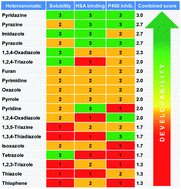The developability of heteroaromatic and heteroaliphatic rings – do some have a better pedigree as potential drug molecules than others?
Abstract
Aqueous solubility,

* Corresponding authors
a
TJR-Chem, Via Alberto 34C, 21020 Ranco (VA), Italy
E-mail:
tim.j.ritchie@gmail.com
Fax: +39 0331 975020
Tel: +39 0331 975020
b
Respiratory CEDD, GlaxoSmithKline Medicines Research Centre, Gunnels Wood Road, Stevenage SG1 2NY, UK
E-mail:
simon.jf.macdonald@gsk.com
c Computational and Structural Chemistry, GlaxoSmithKline Medicines Research Centre, Gunnels Wood Road, Stevenage SG1 2NY, UK
Aqueous solubility,

 Please wait while we load your content...
Something went wrong. Try again?
Please wait while we load your content...
Something went wrong. Try again?
T. J. Ritchie, S. J. F. Macdonald, S. Peace, S. D. Pickett and C. N. Luscombe, Med. Chem. Commun., 2012, 3, 1062 DOI: 10.1039/C2MD20111A
To request permission to reproduce material from this article, please go to the Copyright Clearance Center request page.
If you are an author contributing to an RSC publication, you do not need to request permission provided correct acknowledgement is given.
If you are the author of this article, you do not need to request permission to reproduce figures and diagrams provided correct acknowledgement is given. If you want to reproduce the whole article in a third-party publication (excluding your thesis/dissertation for which permission is not required) please go to the Copyright Clearance Center request page.
Read more about how to correctly acknowledge RSC content.
 Fetching data from CrossRef.
Fetching data from CrossRef.
This may take some time to load.
Loading related content
